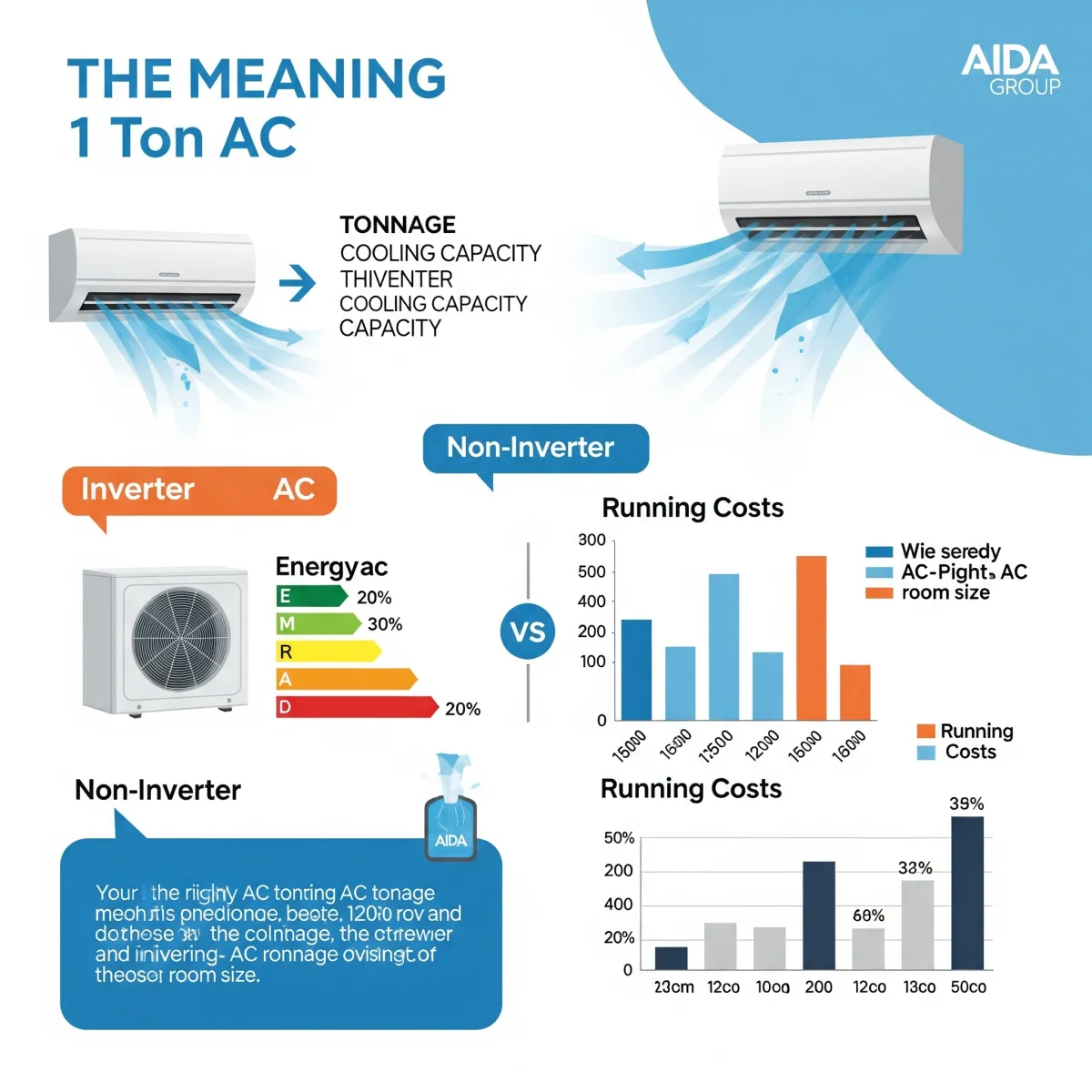
What Does "1 Ton AC" Mean? Inverter vs. Non-Inverter & Running Costs - The Aida Group
What Does "1 Ton AC" Actually Mean? Understanding Your Cooling Power and Costs
What Does "1 Ton AC" Actually Mean?
Have you ever heard someone say, "I have a 1-ton AC at home," and wondered what that "ton" truly signifies in the world of air conditioning? It's a common question, and understanding it is key to appreciating your home's cooling power.
At The Aida Group, we believe in empowering our clients with clear, straightforward information. So, let's demystify the "ton" in AC.

Imagine you have 1,000 kilograms of ice in front of you. A 1-ton AC doesn't mean your air conditioner weighs a ton! Instead, it refers to an air conditioner's cooling capacity. Specifically, a 1-ton AC is capable of removing the same amount of heat from a room in one day that would be needed to melt 1 ton (1,000 kg) of ice. This unit of measurement originated from the cooling effect of melting ice, which was once a primary method of refrigeration.
In technical terms, 1 ton of refrigeration is equivalent to 12,000 British Thermal Units per hour (BTU/hour). BTU is a unit of heat. So, a 1-ton AC can remove 12,000 BTUs of heat from your home every hour. The higher the tonnage, the greater the cooling capacity of the AC unit.
What’s the Difference Between Inverter and Non-Inverter ACs?
Understanding "tonnage" is just the first step. The technology powering your AC unit also plays a crucial role in its performance and, more importantly, your electricity bill. The two primary types are inverter and non-inverter ACs.
If you think of an AC as a car engine, the difference becomes quite clear:
Non-Inverter ACs: These are like a car that can either go at full speed or stop. When a non-inverter AC is turned on, it runs at its maximum power to cool the room. Once the desired temperature is reached, it completely shuts off. As the room warms up again, it switches back on at full power. This frequent start-stop cycle consumes a significant amount of electricity, leading to higher energy bills and often more wear and tear on the unit.
Inverter ACs: Consider an inverter AC like a smart car that can adjust its speed seamlessly. When the room is hot, it works fast to cool it down quickly. Once the room cools to your set temperature, it doesn't shut off entirely. Instead, it slows down and runs at a lower, more consistent speed, maintaining the temperature without repeatedly turning on and off. This continuous, variable operation makes inverter ACs far more energy-efficient, leading to substantial electricity savings and often a quieter operation.
How Much Does a 1-Ton Inverter AC Cost to Run Per Month in Texas?
At The Aida Group, we often get questions about the operational costs of air conditioning, especially in a warm climate like Texas. Let's break down the estimated monthly cost for running a 1-ton inverter AC.
🔹 Step 1: Understand Power Consumption
A 1-ton AC is roughly equivalent to 12,000 BTU/hour.
Inverter ACs are known for their energy efficiency. While consumption can vary, a 1-ton inverter AC generally uses about 0.8 to 1.0 kilowatt-hours (kWh) per hour. For a conservative estimate, we'll use 1.0 kWh/hour.
🔹 Step 2: Calculate Daily and Monthly Usage
Let's assume you run your 1-ton inverter AC for an average of 8 hours a day.
Daily usage: 1.0 kWh/hour × 8 hours = 8 kWh/day
Monthly usage: 8 kWh/day × 30 days = 240 kWh/month
🔹 Step 3: Use Average Electricity Rates in Texas
As of 2025, the average residential electricity cost in Texas hovers around 13¢ per kWh. It's important to note that this can vary, ranging anywhere between 11¢ and 15¢ depending on your specific utility provider, plan, and time of year.
Estimated Monthly Cost: 240 kWh × $0.13 = $31.20
✅ Final Answer:
Based on these calculations, running a 1-ton inverter AC for 8 hours a day can cost you approximately $30–$35 per month in Texas. This estimate can fluctuate depending on your local utility rates, the specific efficiency rating (SEER/EER) of your AC unit, and how consistently it operates.